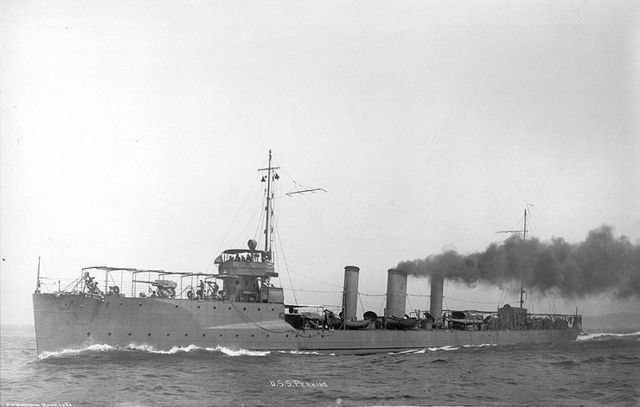The Paulding-class destroyers were a series of United States Navy destroyers derived from the Smith class with the torpedo tubes increased from three to six via twin mounts. They were the first destroyers in the US Navy with oil-fired boilers. The 21 Pauldings doubled the number of destroyers in the US Navy. The Paulding class derived its name from the class's lead ship, Paulding, named for Rear Admiral Hiram Paulding (1797–1878). Like the Smiths, they were nicknamed "flivvers" after the small and shaky Model T Ford once the larger "thousand tonner" destroyers entered service.
USS Paulding at Queenstown, Ireland in 1918
Perkins with three stack design
In naval terminology, a destroyer is a fast, maneuverable, long-endurance warship intended to escort
larger vessels in a fleet, convoy, or carrier battle group and defend them against a wide range of general threats. They were originally conceived in 1885 by Fernando Villaamil for the Spanish Navy as a defense against torpedo boats, and by the time of the Russo-Japanese War in 1904, these "torpedo boat destroyers" (TBDs) were "large, swift, and powerfully armed torpedo boats designed to destroy other torpedo boats". Although the term "destroyer" had been used interchangeably with "TBD" and "torpedo boat destroyer" by navies since 1892, the term "torpedo boat destroyer" had been generally shortened to simply "destroyer" by nearly all navies by the First World War.
USS Arleigh Burke, the lead ship of her class of guided-missile destroyers.
The destroyers of the US Navy's Zumwalt-class, pictured here sailing with a Littoral combat ship (LCS) are the longest and heaviest destroyers currently in service.
The Italian Caio Duilio, belongs to the Horizon-class of Franco-Italian designed first-rate frigates.
Fernando Villaamil, credited as the inventor of the destroyer concept, died in action during the Battle of Santiago de Cuba in 1898.






